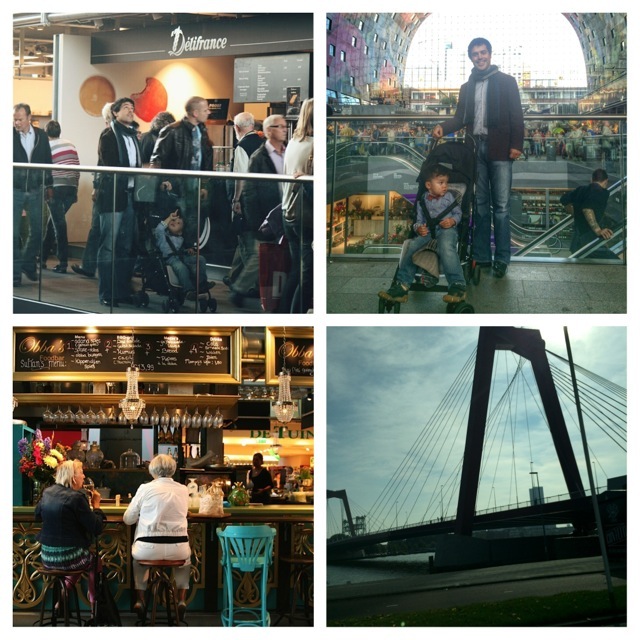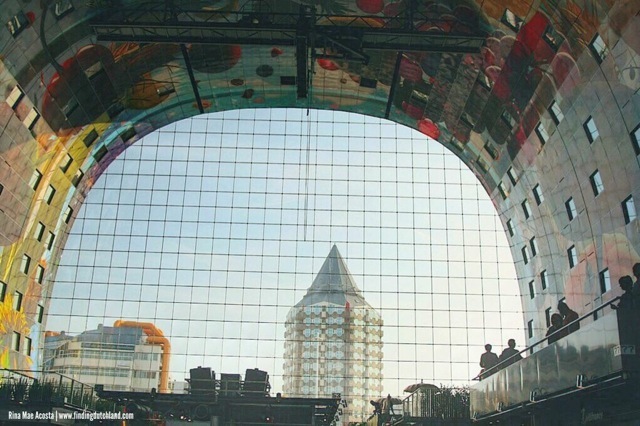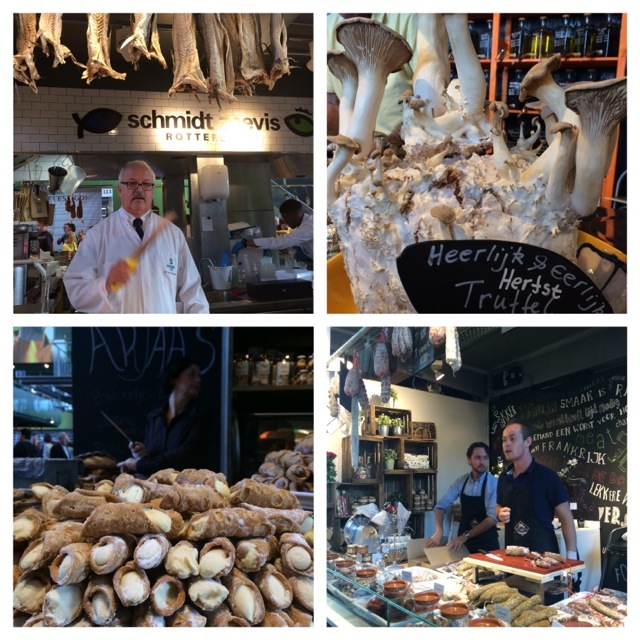The lines of cars filing into the city of Rotterdam were invariably packed with self-proclaimed gourmands, architect buffs, modern art enthusiasts and curious day trippers. They’re eventually met by locals – cyclists and pedestrians – all congregating towards the middle of the city’s sprawling Blaak market square. The sense of urgency and excitement was palpable as they navigated towards parking spaces, entry ways, escalators and elevators. Their faces, softened by the Autumn sunlight, hungrily looked towards a mammoth horseshoe structure.
The building is the Markthal (Market Hall), Rotterdam’s latest architectural pride and joy. Designed by Winy Maas of Dutch architectural firm MVRDV, the country’s first indoor market opened last Wednesday (1 October 2014). It’s a food lover’s mecca – a sistine chapel of market stalls offering local, organic produce, artisanal gourmet crafts, restaurants, and regular Dutch fair. The Markthal is also a living community with 230 apartments built into the arch shaped structure.
The biggest surprise for us was the “Horn of Plenty” – a digital mural of 4,000 tiles that covers 36,000 square feet and displays brilliant high-resolution images of fish, vegetables, fruits and other items. Staring up at the spectacular mural makes one feel like one just went down Alice in Wonderland’s psychedelic rabbit hole. In collaboration with famed cartoon animator Pixar, Dutch artist Arno Coenen created a 3D optical illusion of produce and fauna falling from the sky. It’s art appreciation at its finest as people of all ages seemed mesmerized and in awe of the largest artwork in the world.
And the Markthal is definitely something for Rotterdam to be proud of. Markthal had garnered international intrigue and helped solidify Rotterdam’s place in The New York Times annual 52 Places to Go list in 2014. Not to forget to mention that it’s a “one up” in the friendly rivalry among “Amsterdammers” and “Rotterdammers”. Who could blame the Rotterdammers for being a bit smug and proud, whom like the rest of the tourist-worthy cities like Utrecht and Den Haag, had compete to play second fiddle to her more glamorous, world-renowned sister Amsterdam since time immemorial?
Being a former Erasmus University graduate student (which explains my natural soft spot for Rotterdam), I couldn’t help but contemplate what the implications of installing a luxury, world-class marketplace would have to it’s overall character and personality. Rotterdam has been traditionally characterized as industrious, hardworking, down-to-earth…and working class. According to Judith Thissen in Industrial Cities: History and Future, Rotterdam gained the reputation of being a werkstad – a working class city- as early as the 1870s.
Rotterdam’s evolution from a blue-collar industrial area to an architect’s paradise and now foodie destination has its roots in the city’s seaport – the Port of Rotterdam and World War II. After the Rotterdam Blitz where virtually the entire historic city center was demolished (as informed by every single Rotterdammer who comes across a foreigner or tourist), the reconstruction of Rotterdam became a playground for modernist architects. But the seaport, one of the largest in Europe and considered its gateway, and its middle class laborers, are still the bread and butter of Rotterdam.
The resulting hodgepodge of different modernist architectural styles was an urban city that didn’t fit the Dutch mold of gezelligheid. Local Rotterdam authorities have vocalized for years how difficult it was to attract residents and visitors to the urban jungle of concrete. According to Rotterdam mayor Ahmed Aboutaleb, there was an overall consensus to “draw more residents and visitors to the center of Rotterdam, especially residents with a higher income who consequently support services in the city center.” Hence Markthal is a clear example of attempts at gentrification, a not-so-secret strategy for drawing in wealthier clientele into Rotterdam. But I wondered whether, or not targeting a certain clientele would be at the expense of driving away and alienating everyday citizens.
While we strolled around the expansive Markthal, fighting the infamous Dutch crowds, I realized that my concerns were a bit naive. I made a loud sigh of relief when the everyday items – bread, cheeses, french fries, baked goods, and vegetables – were priced the same as what could be found at any other local market. For example, Mei Sum Bakery offered delicious Asian treats for the same price of €10 for 12 pieces as their flagship location at West Kruiskade. While Markthal might initially seem a bit out of place in juxtaposition to Rotterdam’s more modest character, I can sense the desire of local Rotterdammers (from all different backgrounds) to make something out of their beloved city’s new treasure. In fact, while my heart shouted out with glee with all the wonderful food, I became convinced that the Markthal was the new heart of Rotterdam.

The future looks bright Rotterdam. Welcome to taking your rightful place as a world class destination.
P.S. Come connect with me on my Instragram account. Aside from writing, photography is my other passion.



